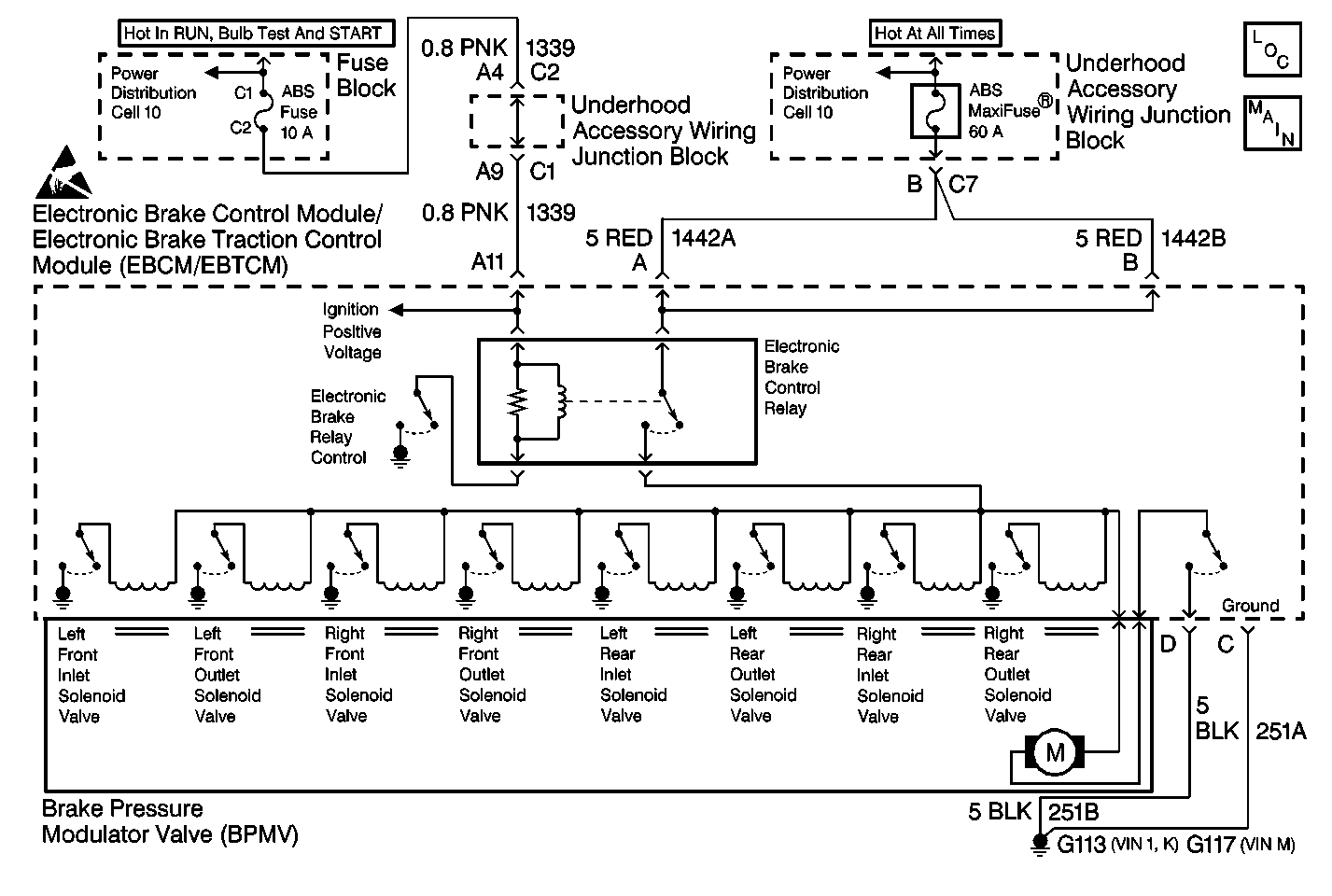
Circuit Description
This circuit is used to monitor the voltage level available to the EBCM/EBTCM. If the voltage drops below 10.5 volts, full performance of the ABS/TCS cannot be guaranteed. During ABS/TCS operation, there are several current requirements that will cause battery voltage to drop. Because of this, voltage is monitored prior to ABS/TCS operation to indicate good charging system condition and also during ABS/TCS operation when voltage may drop significantly.
Conditions for Setting the DTC
DTC C1236 can only be set if the vehicle's speed is greater than 8 km/h (5 mph). If both the battery and ignition voltages are less than 10.8 volts and the vehicle is not in a ABS/TCS condition, a malfunction DTC will set. If the vehicle is in an ABS/TCS condition then the battery and ignition voltages must drop below 9.35 volts for a malfunction DTC to set.
Action Taken When the DTC Sets
| • | A malfunction DTC is stored. |
| • | ABS/TCS is disabled. |
| • | ABS/TCS Indicators are turned on. |
Conditions for Clearing the DTC
| • | Condition for DTC is no longer present and Scan Tool clear DTC function is used. |
| • | 100 Ignition cycles have passed with no DTCs detected. |
Diagnostic Aids
| • | Possible causes for DTC C1236 to set are: |
| - | Charging system malfunction |
| - | Excessive battery draw |
| - | Weak battery |
| - | Faulty engine block ground |
| - | Loose battery cables |
| • | Test the charging system. Refer to Charging System Check in Engine Electrical. |
| • | Check for other low voltage conditions. |
| • | If an intermittent malfunction exists refer to Intermittents and Poor Connections Diagnosis in Wiring Systems. |
| • | It is very important that a thorough inspection of the wiring and connectors be performed. Failure to carefully and fully inspect wiring and connectors may result in misdiagnosis, causing part replacement with reappearance of the malfunction. |
Step | Action | Value(s) | Yes | No |
|---|---|---|---|---|
1 | Was a Diagnostic System Check performed? | -- | ||
2 |
Is the monitored battery voltage greater then the specified value? | 10.8 V | ||
3 | Use a J 39200 DMM to measure the voltage between the battery positive terminal and ground while running the engine at approximately 2000 RPM. Is the voltage greater then the specified value? | 10.8 V | Go to Charging System Check in Engine Electrical | |
4 |
Is the resistance to ground in CKTs 251A and 251B within the specified range? | 0-2 ohms | ||
5 | Repair open or high resistance in CKT 251A and/or CKT 251B. Refer to Wiring Repairs in Wiring Systems. Is the repair complete? | -- | -- | |
6 | Check the ABS MaxiFuse® (60 A) in the underhood accessory wiring junction block for an open circuit. Is the fuse good? | -- | ||
7 |
Is CKT 1442A or CKT 1442B continuous to ground? | -- | ||
8 | Repair a short to ground in CKT 1442A or CKT 1442B. Is the repair complete? | -- | -- | |
9 |
Is the voltage within the specified range? | 10.0-14.0 V | ||
10 | Repair the open or high resistance in CKT 1442A and/or CKT 1442B. Is the repair complete? | -- | -- | |
11 | Check the ABS Fuse (10 A) in the underhood accessory wiring junction block for an open circuit. Is the fuse good? | -- | ||
12 |
Is CKT 1339 continuous to ground? | -- | ||
13 | Repair a short to ground in CKT 1339. Is the repair complete? | -- | -- | |
14 |
Is the voltage within the specified range? | 10.0-14.0 V | ||
15 | Repair the open or high resistance in CKT 1339. Is the repair complete? | -- | -- | |
16 |
Did DTC C1236 reset as a current DTC? | -- | ||
17 | Replace the EBCM/EBTCM. Refer to Electronic Brake Control Module/Electronic Brake and Track Control Module Replacement . Is the repair complete? | -- | -- |
